Inside this Article
Glossary
| Climate Tech | Technologies designed to mitigate climate change. This includes innovations in renewable energy, energy efficiency, carbon capture, and eco-friendly materials, aimed at reducing global greenhouse gas emissions. |
| Renewable Energy | Energy from sources from the earth that can be replenished; for example, ethanol made from agricultural waste. These energy sources are seen as climate friendly because their production doesn’t cause additional pollution or damage to the environment. |
| Sustainable Energy | Energy from sources that are inexhaustible and do not need to be replenished; for example, sunlight, wind, rain, tides, waves, and geothermal heat. These sources can meet our demands without deteriorating or running out. |
| Clean Energy | Energy forms and technologies that generate minimal or no greenhouse gas emissions, and therefore have a smaller environmental footprint than fossil fuel sources. Clean energy technologies include sustainable energy sources like wind and solar, as well as nuclear power and advanced carbon capture and storage techniques. |
| Carbon Capture & Storage (CCS) | A technology that captures carbon dioxide emissions produced from the use of fossil fuels in electricity generation and industrial processes, preventing it from entering the atmosphere and contributing to global warming. |
| Net-Zero Emissions Goals | Targets set by countries, cities, or businesses to balance the amount of greenhouse gasses they emit with the amount they remove from the atmosphere, achieving a theoretical zero (net zero) in emissions by a specified future date. |
| Paris Climate Agreement | An international treaty signed by 196 parties in 2015, aiming to limit global warming to below 2°C – preferably to 1.5°C – compared to pre-industrial levels. |
| Circular Economy | An economic model designed to counter the wastefulness of the traditional linear economy – where goods are manufactured from raw materials, used, and then discarded. By emphasizing the elimination of waste and the continuous reuse of resources, circular systems embrace reuse, sharing, repair, refurbishment, remanufacturing, and recycling to form a closed-loop system. |
| Smart Grid | An electricity supply network that uses digital communications technology to detect and respond to local changes in usage and storage needs. Smart grids support the integration of renewable energy sources, improve system reliability, and enable real-time energy management. |
| Green Technology | The application of environmental science to conserve the natural environment and resources, thereby reducing negative impacts of human involvement. |
| Electrification | The process of replacing technologies that use fossil fuels with those that use electricity as a source of energy. It often refers to using sustainable electricity to power transportation, heating, and other applications. |
| Inflation Reduction Act (IRA) | A US law enacted in 2022 and aimed at reducing inflation by investing in domestic energy production and lowering prescription drug prices. It includes significant provisions for climate change mitigation, such as incentives for clean energy production and carbon capture technologies. |
| Geothermal Energy | Heat derived from the earth’s interior. Geothermal energy is sustainable and can be harnessed for heating, cooling, or generating electricity through the use of steam or hot water from underground reservoirs. |
| Biofuels | Fuels produced from organic materials or biomass, such as plants and waste. Biofuels are considered renewable and can replace gasoline and diesel for transportation, reducing greenhouse gas emissions compared to fossil fuels. |
| Green Buildings | Structures designed, constructed, and operated to minimize the total environmental impacts. Green buildings use energy, water, and materials more efficiently and create healthier environments for people to live and work in. |
| Climate Tech Unicorn/Decacorn | Startups in the climate technology sector valued at over $1 billion (unicorn) and over $10 billion (decacorn). These companies are at the forefront of developing innovative solutions to combat climate change. |
| Carbon Sequestration | The process of capturing atmospheric carbon dioxide and storing it in a solid or liquid form, either through biological processes (such as photosynthesis in plants) or technological methods (such as direct air capture and storage). |
| Green Skills | Skills needed in the workforce to support a sustainable economy, including the knowledge, abilities, values, and attitudes required for environmentally friendly production processes and the development and use of clean technology. |
The Climate Tech Market at a Glance
With the climate tech market projected to hit $183 billion by 2033, we can see that the fight against climate change is accelerating, backed by real money and real growth. Below, we look at the surge in climate tech companies and investments in the global push for sustainability. This is a signal of where the world is heading and understanding these trends is essential for anyone tracking environmental innovation.#1: Global Climate Tech Market
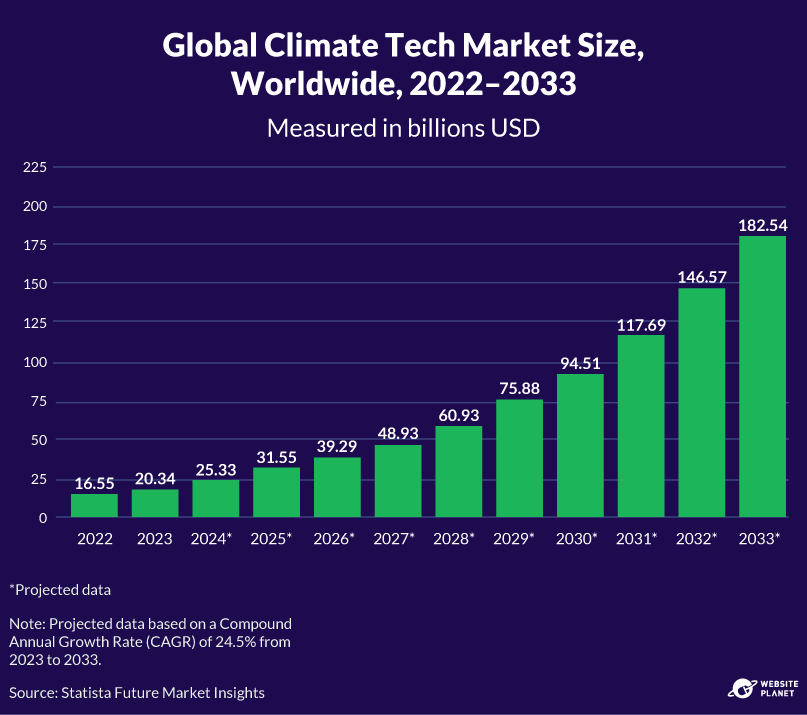 The global climate tech market was valued at $20.34 billion in 2023, a 23% increase from 2022. It’s projected to grow at a rate of 24.5% per year to reach a value of $183 billion by 2033.
This growth has largely been fueled by increased awareness of and concern over the climate crisis as well as nations’ commitments under the Paris Agreement. The economic benefits that developing this technology may bring are likely also a motivating factor here.
The global climate tech market was valued at $20.34 billion in 2023, a 23% increase from 2022. It’s projected to grow at a rate of 24.5% per year to reach a value of $183 billion by 2033.
This growth has largely been fueled by increased awareness of and concern over the climate crisis as well as nations’ commitments under the Paris Agreement. The economic benefits that developing this technology may bring are likely also a motivating factor here.
#2: How Many Companies Are Tackling Climate Change?
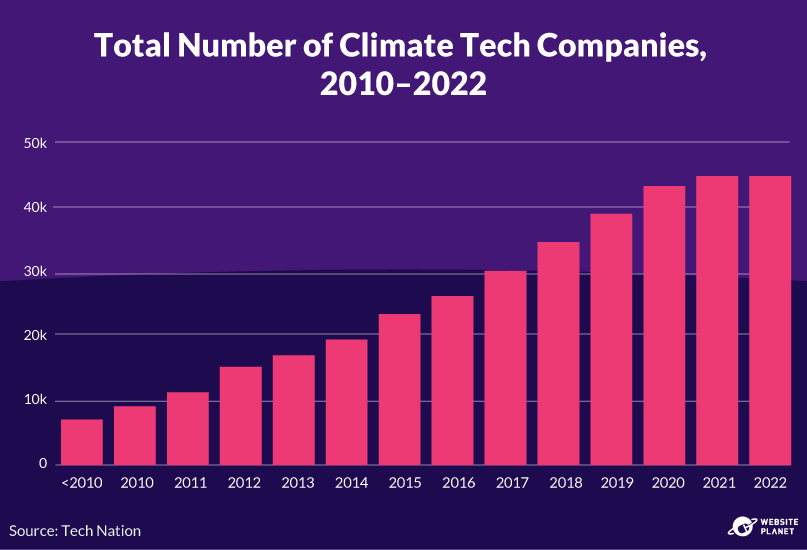 There were 44,595 climate tech companies in operation in 2022, more than quadruple the number that were present in the market in 2010.
Although the rate of growth has slowed somewhat over the past few years, projections suggest that the upward trajectory will continue, with the number of climate tech firms anticipated to reach 66,500 by 2030.
This uptick in the number of climate tech companies has been spurred by increased investment from both the public and private sectors. As governments implement mandates and regulations to combat climate change, and awareness of environmental issues becomes more mainstream, investors are increasingly drawn to the potential of climate tech.
There were 44,595 climate tech companies in operation in 2022, more than quadruple the number that were present in the market in 2010.
Although the rate of growth has slowed somewhat over the past few years, projections suggest that the upward trajectory will continue, with the number of climate tech firms anticipated to reach 66,500 by 2030.
This uptick in the number of climate tech companies has been spurred by increased investment from both the public and private sectors. As governments implement mandates and regulations to combat climate change, and awareness of environmental issues becomes more mainstream, investors are increasingly drawn to the potential of climate tech.
#3: Which Nations Are Leading in Climate Tech Investment?
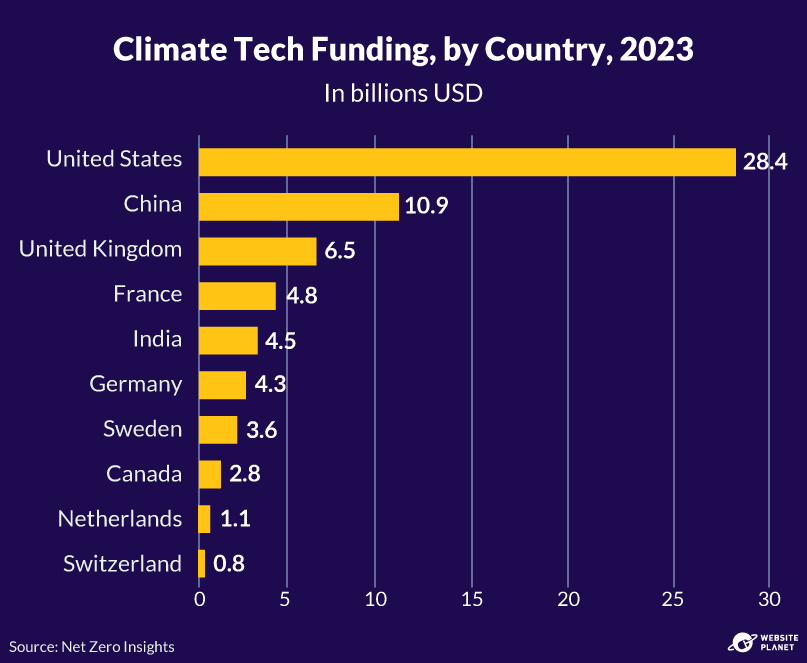 Global climate tech funding amounted to $72.9 billion in 2023, which was quite a decrease from the $102.5 billion recorded in 2022.
Still, in 2023, the United States led the climate tech funding landscape, attracting over $28.4 billion – more than 40% of the global funding in this sector. China and the United Kingdom were also key players, securing $10.9 billion and $6.5 billion, respectively.
However, cities like Stockholm topped the list for individual city funding, securing $3.4 billion in 2023. London and Mumbai followed with $3.3 billion and $2 billion, respectively.
Global climate tech funding amounted to $72.9 billion in 2023, which was quite a decrease from the $102.5 billion recorded in 2022.
Still, in 2023, the United States led the climate tech funding landscape, attracting over $28.4 billion – more than 40% of the global funding in this sector. China and the United Kingdom were also key players, securing $10.9 billion and $6.5 billion, respectively.
However, cities like Stockholm topped the list for individual city funding, securing $3.4 billion in 2023. London and Mumbai followed with $3.3 billion and $2 billion, respectively.
#4: Climate Tech Startup Growth in the Global North
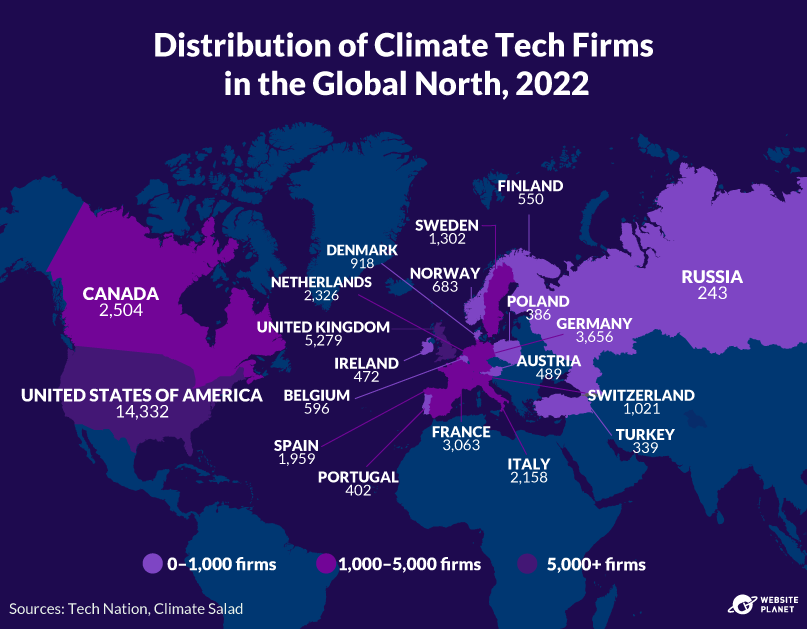 The number of climate tech startups and scaleups in the Global North expanded to around 45,000 in 2022.
The US led the pack with over 14,300 companies. Despite its tech market being roughly a third of the size of the US, the UK followed with 5,279 firms. This underscores its position as Europe’s leading climate tech hub.
Germany came in third with 3,656 companies, closely followed by France (3,063). The worst-performing countries in the Global North in terms of climate tech start-up growth were Australia (228), Russia (243), Turkey (339), and Poland (386).
The number of climate tech startups and scaleups in the Global North expanded to around 45,000 in 2022.
The US led the pack with over 14,300 companies. Despite its tech market being roughly a third of the size of the US, the UK followed with 5,279 firms. This underscores its position as Europe’s leading climate tech hub.
Germany came in third with 3,656 companies, closely followed by France (3,063). The worst-performing countries in the Global North in terms of climate tech start-up growth were Australia (228), Russia (243), Turkey (339), and Poland (386).
#5: Top Climate Tech Unicorns of 2024
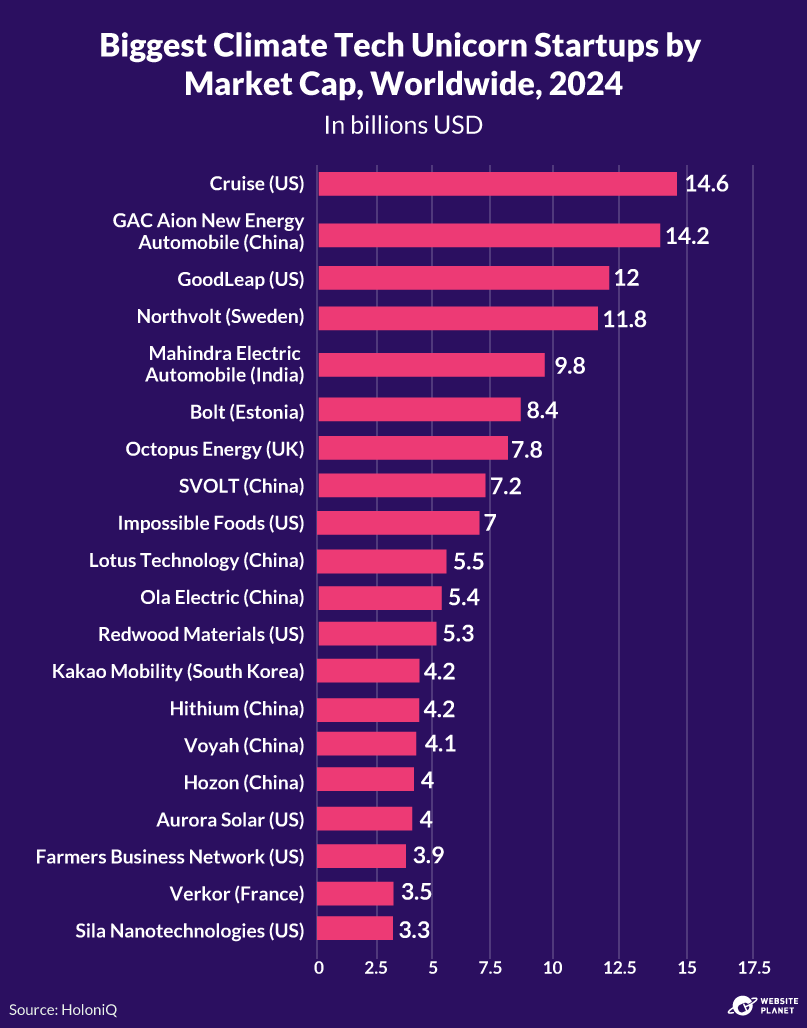 Climate tech unicorns – private startup companies valued at over $1 billion – are making significant strides by reducing emissions, improving energy efficiency, and advancing sustainable transportation.
As of 2024, the world’s leading climate tech unicorns have a combined valuation of $140 billion, with the majority (14 of the top 20) based in the US and China. Leading the pack is Cruise, a US-based self-driving car company, with a valuation of $14.6 billion.
Beyond transportation, the top climate tech unicorns are also found in sectors like finance, renewable energy, and alternative foods.
Climate tech unicorns – private startup companies valued at over $1 billion – are making significant strides by reducing emissions, improving energy efficiency, and advancing sustainable transportation.
As of 2024, the world’s leading climate tech unicorns have a combined valuation of $140 billion, with the majority (14 of the top 20) based in the US and China. Leading the pack is Cruise, a US-based self-driving car company, with a valuation of $14.6 billion.
Beyond transportation, the top climate tech unicorns are also found in sectors like finance, renewable energy, and alternative foods.
#6: Mineral Demand in the Age of Clean Energy Technologies
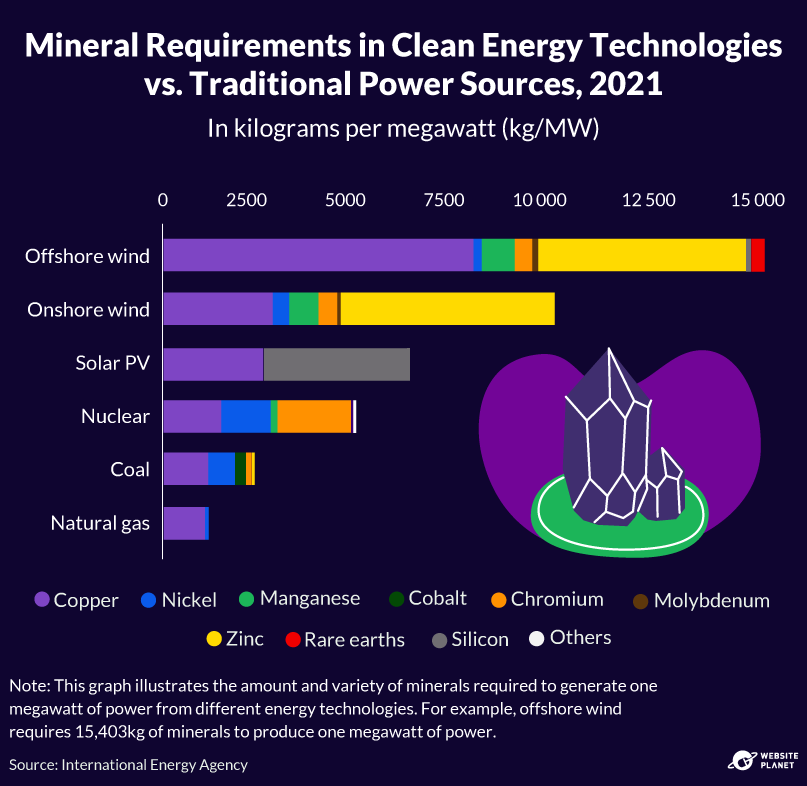 The clean energy transition is driving up the demand for key minerals – like copper, zinc, and lithium – that are vital for building renewable energy technologies. Electric vehicles and onshore wind farms, for example, are far more mineral-intensive than their conventional counterparts.
However, the extraction of these minerals has its drawbacks. Copper mining is particularly water-intensive, leading to pollution concerns. In the Democratic Republic of the Congo, where most of the world’s cobalt is sourced, mining practices are fraught with dangerous working conditions and human rights violations, including the use of child labor.
The clean energy transition is driving up the demand for key minerals – like copper, zinc, and lithium – that are vital for building renewable energy technologies. Electric vehicles and onshore wind farms, for example, are far more mineral-intensive than their conventional counterparts.
However, the extraction of these minerals has its drawbacks. Copper mining is particularly water-intensive, leading to pollution concerns. In the Democratic Republic of the Congo, where most of the world’s cobalt is sourced, mining practices are fraught with dangerous working conditions and human rights violations, including the use of child labor.
Technologies
Every piece of climate technology is a part of a larger puzzle aimed at healing our planet. From smart grids and green buildings that fine-tune our energy consumption to e-bikes and electric vehicles reducing our reliance on fossil fuels, we see an array of solutions coming together. Even beyond our atmosphere, in-space manufacturing brings sustainable practices to the cosmos. These technologies have the potential to redefine how we live, work, and interact with our environment. Going green isn’t just possible – it’s happening.#7: Smart Grids Powering the Future
 The smart grid market is projected to grow at a 17.4% CAGR, reaching over $130 billion by 2028 from a valuation of just below $50 billion in 2022.
A smart grid digitally monitors and manages how electricity flows from generation sources to users, matching supply with demand. These grids use technologies like Advanced Metering Infrastructure (AMI), which collect and analyze usage data, making it easier to manage how much energy we use.
The total capacity of smart grid storage increased by about 11 GW to reach nearly 28 GW in 2022, a 75% increase from the previous year. To meet climate goals, we need 970 GW by 2030, about 120 GW each year to stay on track.
The smart grid market is projected to grow at a 17.4% CAGR, reaching over $130 billion by 2028 from a valuation of just below $50 billion in 2022.
A smart grid digitally monitors and manages how electricity flows from generation sources to users, matching supply with demand. These grids use technologies like Advanced Metering Infrastructure (AMI), which collect and analyze usage data, making it easier to manage how much energy we use.
The total capacity of smart grid storage increased by about 11 GW to reach nearly 28 GW in 2022, a 75% increase from the previous year. To meet climate goals, we need 970 GW by 2030, about 120 GW each year to stay on track.
#8: E-Bikes Are Powering Global Mobility and Sustainability
 The global e-bike market is on the rise. Its value is expected to increase from $49.1 billion in 2023 to $62.3 billion by 2028. This growth is fueled by growing environmental awareness and e-bikes becoming more affordable.
These battery-powered bikes offer a cleaner alternative for urban travel than cars and other fossil fuel-powered transport. This is especially true when e-bikes are powered by renewable energy, which significantly cuts down carbon emissions compared to traditional modes of transport.
However, e-bike’s potential to transform urban transportation faces hurdles; for example, cities that aren’t designed for cycling. Adjusting urban infrastructure to better accommodate e-bikes, such as creating more bike lanes and integrating e-bikes with public transport, could further boost their adoption.
The global e-bike market is on the rise. Its value is expected to increase from $49.1 billion in 2023 to $62.3 billion by 2028. This growth is fueled by growing environmental awareness and e-bikes becoming more affordable.
These battery-powered bikes offer a cleaner alternative for urban travel than cars and other fossil fuel-powered transport. This is especially true when e-bikes are powered by renewable energy, which significantly cuts down carbon emissions compared to traditional modes of transport.
However, e-bike’s potential to transform urban transportation faces hurdles; for example, cities that aren’t designed for cycling. Adjusting urban infrastructure to better accommodate e-bikes, such as creating more bike lanes and integrating e-bikes with public transport, could further boost their adoption.
#9: Windows to the Future, the Growing Solar PV Glass Market
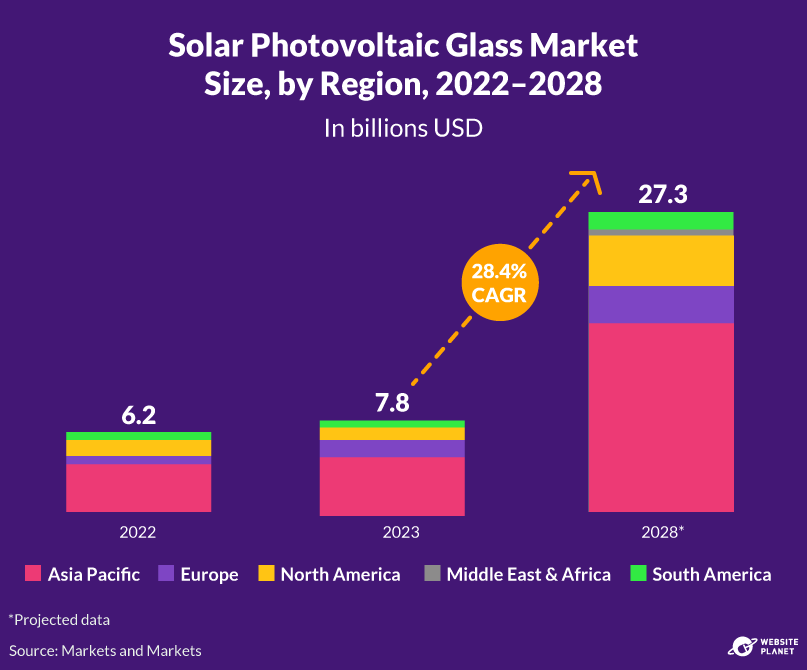 The solar photovoltaic (PV) glass market is experiencing significant growth, expected to hit $27.3 billion by 2028, growing at a rate of 28.4% per year.
This technology, which incorporates solar cells into glass to generate electricity, offers a promising solution to meet a significant portion of energy demands, including the potential to fulfill 40% of the US’ needs in the future.
Solar windows are gaining momentum in Europe, too. Physee, a company based in the Netherlands, is installing 15,000 of their “SmartWindows” in various office buildings throughout Europe. The company claims its windows can reduce energy costs by up to 30%
The solar photovoltaic (PV) glass market is experiencing significant growth, expected to hit $27.3 billion by 2028, growing at a rate of 28.4% per year.
This technology, which incorporates solar cells into glass to generate electricity, offers a promising solution to meet a significant portion of energy demands, including the potential to fulfill 40% of the US’ needs in the future.
Solar windows are gaining momentum in Europe, too. Physee, a company based in the Netherlands, is installing 15,000 of their “SmartWindows” in various office buildings throughout Europe. The company claims its windows can reduce energy costs by up to 30%
#10: The Rise of Electric Vehicles in the Transportation Sector
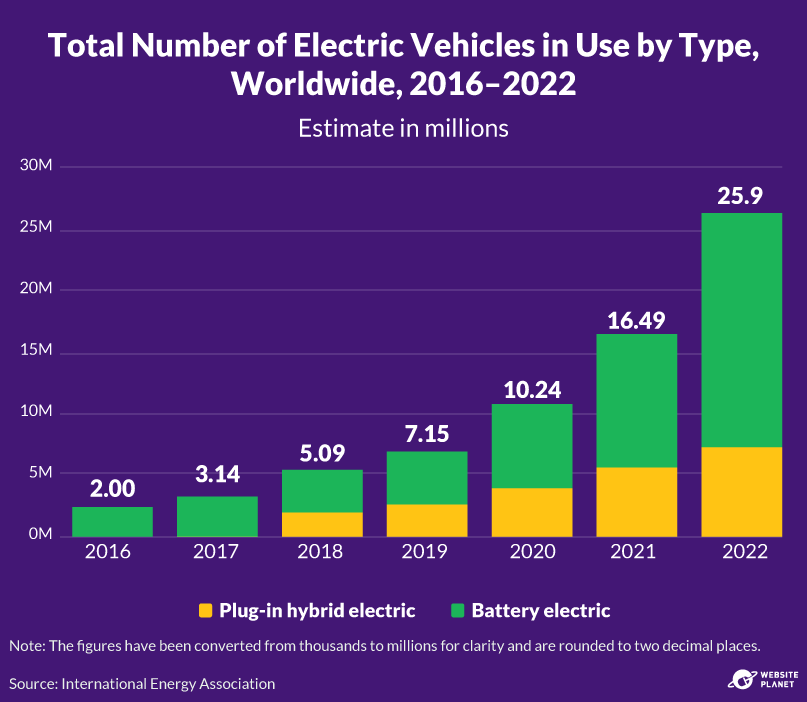 Electric vehicle (EV) sales are accelerating. There were 10.64 million of these vehicles sold worldwide in 2023 and it’s expected that this number will surge to 17.07 million by 2028. This increase will boost the overall market value to $906.7 billion that same year.
China is leading global EV sales, having sold more electric vehicles in 2021 than the rest of the world combined. Chinese manufacturer BYD has surpassed Tesla as the top producer, buoyed by its affordable pricing and the Chinese market’s rapid expansion thanks to government subsidies.
Electric vehicle (EV) sales are accelerating. There were 10.64 million of these vehicles sold worldwide in 2023 and it’s expected that this number will surge to 17.07 million by 2028. This increase will boost the overall market value to $906.7 billion that same year.
China is leading global EV sales, having sold more electric vehicles in 2021 than the rest of the world combined. Chinese manufacturer BYD has surpassed Tesla as the top producer, buoyed by its affordable pricing and the Chinese market’s rapid expansion thanks to government subsidies.
#11: The Promise of No-Till Farming
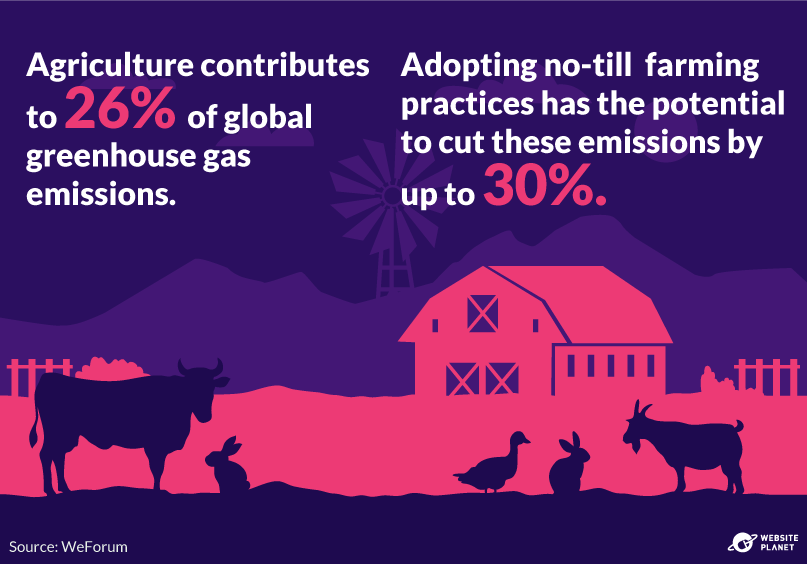 Agriculture accounts for 26% of global greenhouse gas emissions, with soil tilling – a method that releases buried carbon dioxide – often overlooked as a significant source. This practice exposes carbon to air, allowing its conversion to CO2.
A viable alternative is no-till farming, which minimizes soil disruption by directly seeding into the ground. This method retains soil carbon, potentially reducing emissions by up to 30%, while enhancing soil’s capacity to store carbon. As a result, no-till farming is recognized for both mitigating climate impact and improving soil health.
However, the uptake of no-till farming has been slow. Factors hindering its wider adoption include the upfront costs of necessary equipment and concerns over initial dips in yield. However, the long-term benefits, such as lower operational costs and the natural improvement of soil health, underscore its potential in sustainable agriculture.
Agriculture accounts for 26% of global greenhouse gas emissions, with soil tilling – a method that releases buried carbon dioxide – often overlooked as a significant source. This practice exposes carbon to air, allowing its conversion to CO2.
A viable alternative is no-till farming, which minimizes soil disruption by directly seeding into the ground. This method retains soil carbon, potentially reducing emissions by up to 30%, while enhancing soil’s capacity to store carbon. As a result, no-till farming is recognized for both mitigating climate impact and improving soil health.
However, the uptake of no-till farming has been slow. Factors hindering its wider adoption include the upfront costs of necessary equipment and concerns over initial dips in yield. However, the long-term benefits, such as lower operational costs and the natural improvement of soil health, underscore its potential in sustainable agriculture.
#12: Biofuel Production: Fueling the Future
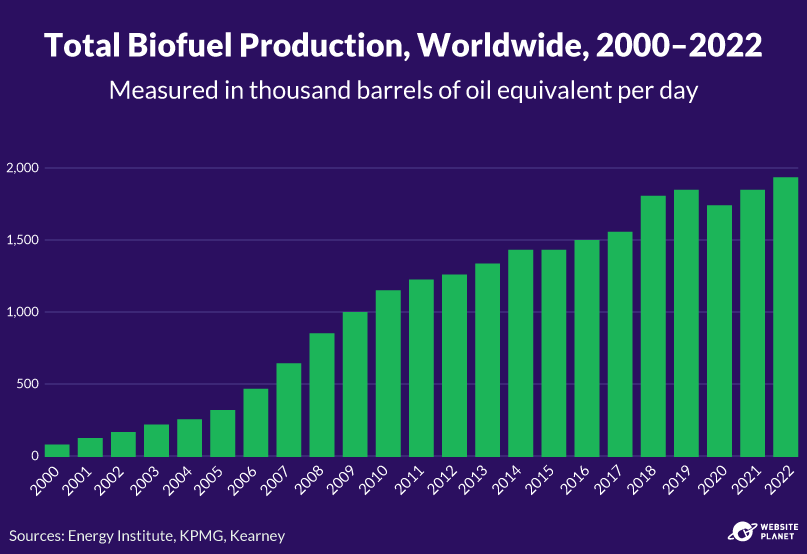 Biofuels are gaining ground due to their lighter carbon footprint and supportive policies. Production rocketed from 180,000 barrels per day in 2000 to 1.9 million in 2022.
Bioethanol and biodiesel lead the biofuel types. They’re made from crops such as coarse grains and sugarcane, and fats or oils like vegetable oil, respectively. While their combustion does emit CO2, their lifecycle is more carbon-neutral compared to traditional fuels, due to their renewable origins.
Biofuels are gaining ground due to their lighter carbon footprint and supportive policies. Production rocketed from 180,000 barrels per day in 2000 to 1.9 million in 2022.
Bioethanol and biodiesel lead the biofuel types. They’re made from crops such as coarse grains and sugarcane, and fats or oils like vegetable oil, respectively. While their combustion does emit CO2, their lifecycle is more carbon-neutral compared to traditional fuels, due to their renewable origins.
#13: Green Buildings Benefit the Environment
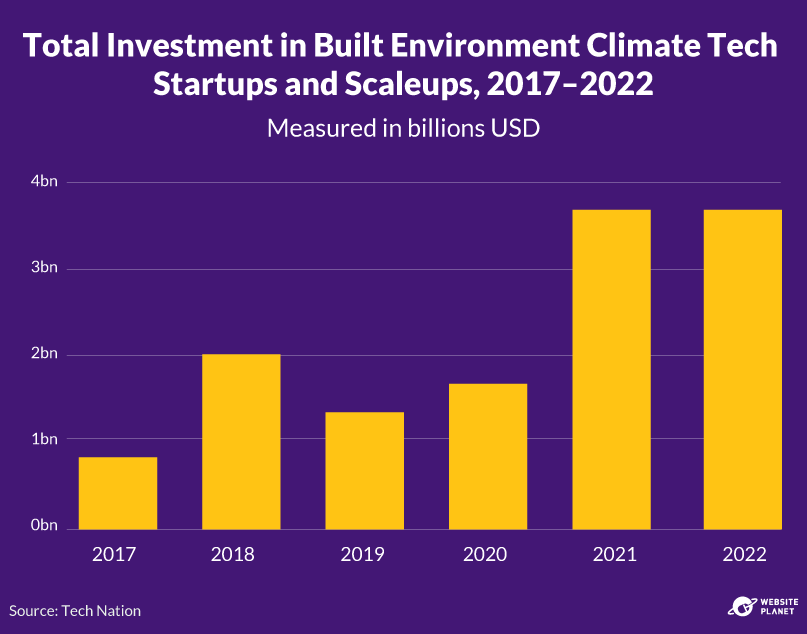 Buildings account for approximately 40% of US CO2 emissions, mainly from energy consumption for heating, cooling, and power.
Green buildings, designed to be energy-efficient and environmentally friendly, can significantly cut these emissions. They’re projected to reduce CO2 emissions by 34% per building, making them both a sustainable and profitable investment.
By using energy-efficient appliances, LED lighting, and green infrastructure, they combat urban heat islands – areas that retain heat from the sun and get hotter than their surroundings – while also reducing energy costs for tenants or owners.
Buildings account for approximately 40% of US CO2 emissions, mainly from energy consumption for heating, cooling, and power.
Green buildings, designed to be energy-efficient and environmentally friendly, can significantly cut these emissions. They’re projected to reduce CO2 emissions by 34% per building, making them both a sustainable and profitable investment.
By using energy-efficient appliances, LED lighting, and green infrastructure, they combat urban heat islands – areas that retain heat from the sun and get hotter than their surroundings – while also reducing energy costs for tenants or owners.
#14: Untapped Potential in the Circular Economy
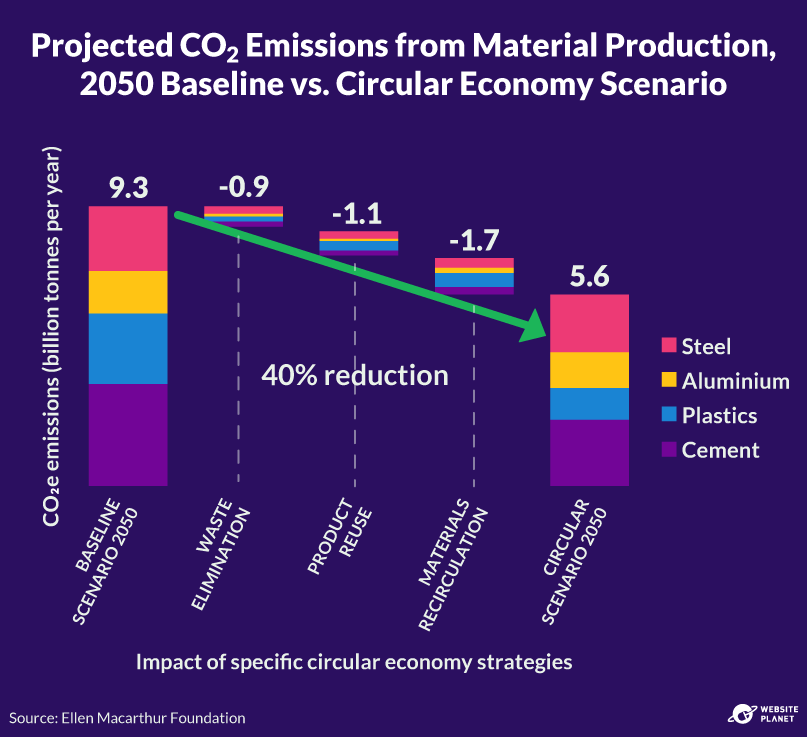 Adopting a circular economy has the potential to cut global CO2 emissions by up to 40% by 2050. This starkly contrasts with our current linear economy system, which only recycles 7.2% of materials. Circular solutions focus on maximizing product longevity and recycling to minimize waste.
In Ghana, construction projects using recycled plastics are a prime example of the circular economy in action. A new library built in Kokrobite in 2023 used 45,000 recycled plastic bottles as a substitute for traditional building materials. Larger bottles packed with soil were used in place of bricks, while smaller bottles were stacked to create columns.
Adopting a circular economy has the potential to cut global CO2 emissions by up to 40% by 2050. This starkly contrasts with our current linear economy system, which only recycles 7.2% of materials. Circular solutions focus on maximizing product longevity and recycling to minimize waste.
In Ghana, construction projects using recycled plastics are a prime example of the circular economy in action. A new library built in Kokrobite in 2023 used 45,000 recycled plastic bottles as a substitute for traditional building materials. Larger bottles packed with soil were used in place of bricks, while smaller bottles were stacked to create columns.
#15: Global Lithium-Ion Battery Recycling Market
 The lithium-ion battery recycling sector is experiencing robust growth. The market value sat at an estimated $6.5 billion in 2022 and is projected to grow at 20% per year to 2031, reaching $35.1 billion.
Companies like Canada’s Li-Cycle are pioneering efficient recycling methods, recovering up to 95% of critical materials from end-of-life batteries. By 2035, around 5 million tons of these batteries are expected to be available for recycling, potentially supplying 15% to 30% of the metals used in new batteries.
The lithium-ion battery recycling sector is experiencing robust growth. The market value sat at an estimated $6.5 billion in 2022 and is projected to grow at 20% per year to 2031, reaching $35.1 billion.
Companies like Canada’s Li-Cycle are pioneering efficient recycling methods, recovering up to 95% of critical materials from end-of-life batteries. By 2035, around 5 million tons of these batteries are expected to be available for recycling, potentially supplying 15% to 30% of the metals used in new batteries.
#16: The Global Geothermal Market
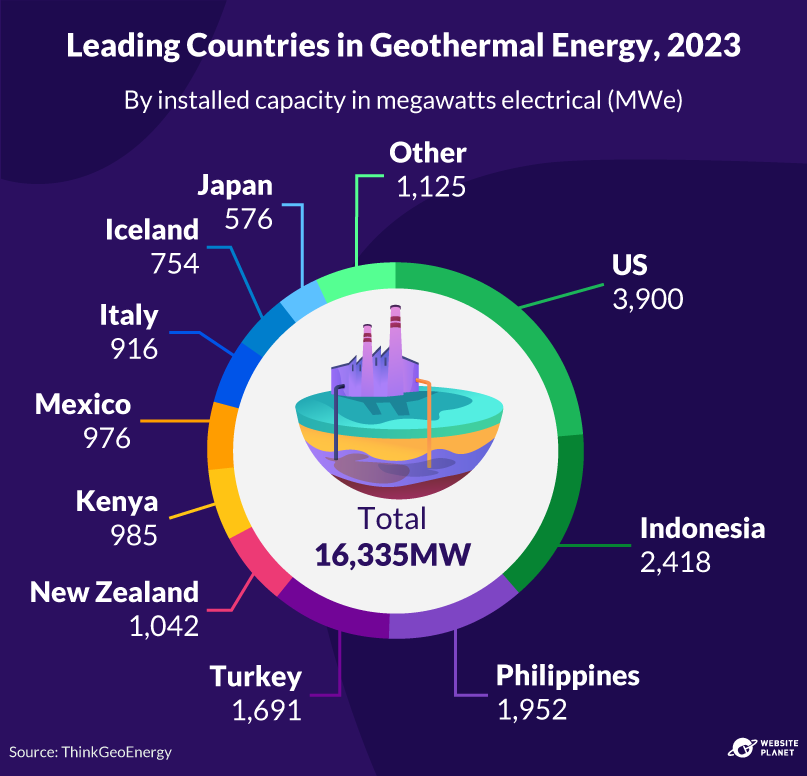 Geothermal energy, harnessed from the Earth’s heat, is gaining ground in the renewable energy sector.
This growth is being driven by an increasing demand for clean energy and supportive policies, like the European Commission’s renewable strategy that aims to triple geothermal’s contribution to the EU’s energy production by 2030.
In 2023, the US topped the charts as the country with the highest geothermal power generation capacity of 3,900 MW, followed by Indonesia (2,418 MW), and the Philippines (1,952 MW). The combined capacity of the top 10 geothermal countries hit 16,335 MW by year-end, making it clear that the benefits of geothermal energy are being recognized globally.
Geothermal energy, harnessed from the Earth’s heat, is gaining ground in the renewable energy sector.
This growth is being driven by an increasing demand for clean energy and supportive policies, like the European Commission’s renewable strategy that aims to triple geothermal’s contribution to the EU’s energy production by 2030.
In 2023, the US topped the charts as the country with the highest geothermal power generation capacity of 3,900 MW, followed by Indonesia (2,418 MW), and the Philippines (1,952 MW). The combined capacity of the top 10 geothermal countries hit 16,335 MW by year-end, making it clear that the benefits of geothermal energy are being recognized globally.
#17: In-Space Manufacturing Can Help to Combat Climate Change
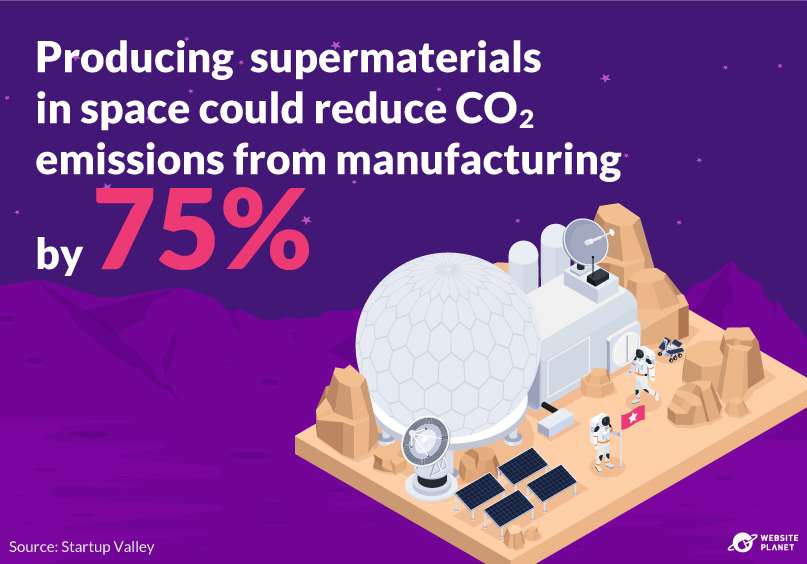 The manufacturing industry is responsible for one-fifth of global carbon emissions and 54% of the world’s energy usage. But solutions are being developed to reduce these emissions.
In-space manufacturing harnesses the unique conditions of space – microgravity, vacuum, and controlled temperatures – to create super materials with enhanced performance and efficiency. This manufacturing method could cut CO2 emissions by 75% by enhancing the efficiency of sustainable technologies on Earth far beyond current capabilities.
Several companies are exploring the in-space manufacturing domain and Space Forge is at the forefront of the industry. The company has secured Europe’s largest seed investment for a space tech company at $10.2 million, as well as a $2.4 million contract from the European Space Agency’s Boost! program.
The manufacturing industry is responsible for one-fifth of global carbon emissions and 54% of the world’s energy usage. But solutions are being developed to reduce these emissions.
In-space manufacturing harnesses the unique conditions of space – microgravity, vacuum, and controlled temperatures – to create super materials with enhanced performance and efficiency. This manufacturing method could cut CO2 emissions by 75% by enhancing the efficiency of sustainable technologies on Earth far beyond current capabilities.
Several companies are exploring the in-space manufacturing domain and Space Forge is at the forefront of the industry. The company has secured Europe’s largest seed investment for a space tech company at $10.2 million, as well as a $2.4 million contract from the European Space Agency’s Boost! program.
Investment and Finance
Is investing in climate tech the new gold rush? Let’s look at the intricate landscape of investment and finance in climate tech, pinpointing which sectors and regions are drawing the most attention and capital. By examining these trends, we can gain insight into how these financial currents are shaping the future of environmental innovation. When it comes to saving the planet, every dollar counts towards a greener future.#18: Climate Tech Funding Slowed Down in 2023
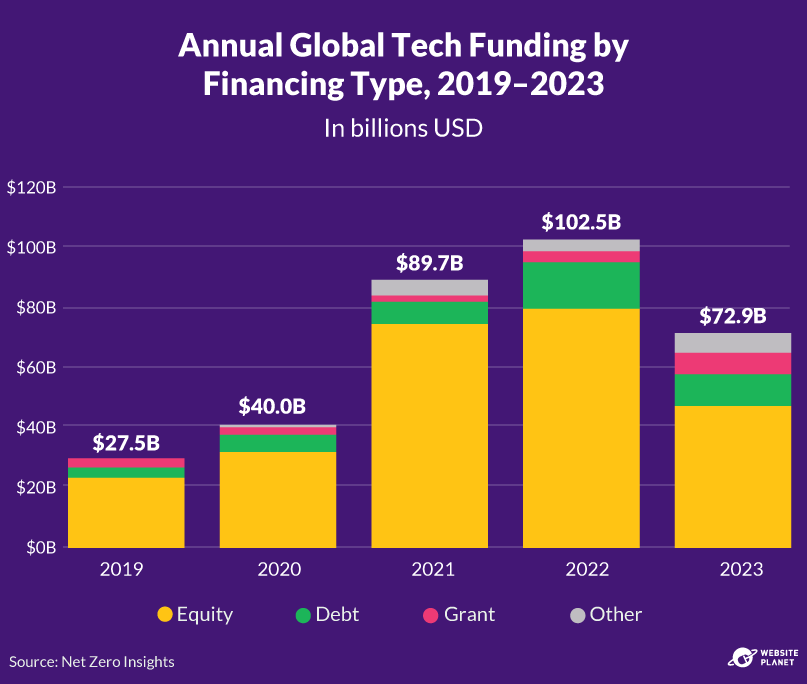 Like other tech sectors, climate tech saw a notable dip in funding in 2023, with total investments falling to $72.98 billion. This is a notable step down from the previous year’s high of $102.5 billion.
The dip in funding comes at a time when the public markets are less receptive to new offerings, leading to a rise in company buyouts rather than initial public offerings (IPOs). This decline points to a more cautious investment climate, with funding still heavily directed towards initiatives aimed at mitigating climate change – a solid 73% of the total.
Like other tech sectors, climate tech saw a notable dip in funding in 2023, with total investments falling to $72.98 billion. This is a notable step down from the previous year’s high of $102.5 billion.
The dip in funding comes at a time when the public markets are less receptive to new offerings, leading to a rise in company buyouts rather than initial public offerings (IPOs). This decline points to a more cautious investment climate, with funding still heavily directed towards initiatives aimed at mitigating climate change – a solid 73% of the total.
#19: Venture Capitalists Move Away from Climate Tech
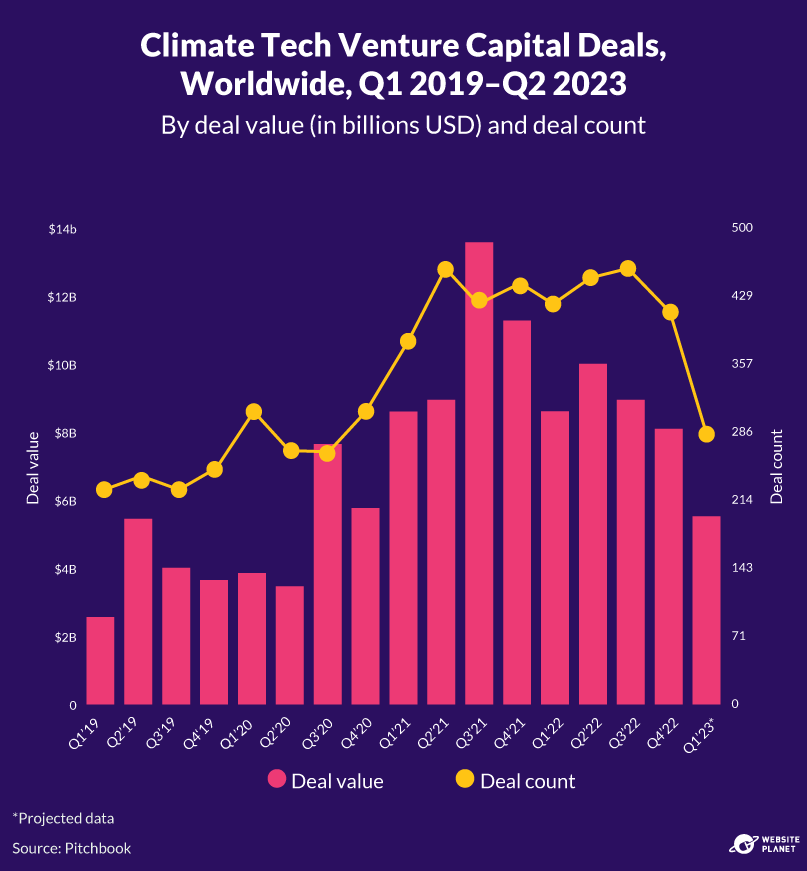 Climate tech funding has hit a rough patch, with venture capital (VC) funding dropping 40% to $13.1 billion in the first half of 2023, even with an 8% increase in the number of deals. The overall cooling in the market is particularly evident in growth funding, which declined by 64%.
Things are a little different for businesses at the seed stage, however. These companies saw a 23% boost in funding, indicating continued investor interest in nurturing new climate technologies.
However, sectors like transport, energy, and food – key areas of climate tech – faced around a 50% funding cut, reflecting a broader market recalibration influenced by the end of zero-interest-rate policies.
Climate tech funding has hit a rough patch, with venture capital (VC) funding dropping 40% to $13.1 billion in the first half of 2023, even with an 8% increase in the number of deals. The overall cooling in the market is particularly evident in growth funding, which declined by 64%.
Things are a little different for businesses at the seed stage, however. These companies saw a 23% boost in funding, indicating continued investor interest in nurturing new climate technologies.
However, sectors like transport, energy, and food – key areas of climate tech – faced around a 50% funding cut, reflecting a broader market recalibration influenced by the end of zero-interest-rate policies.
#20: Most Popular Industries for Investment in Climate Tech
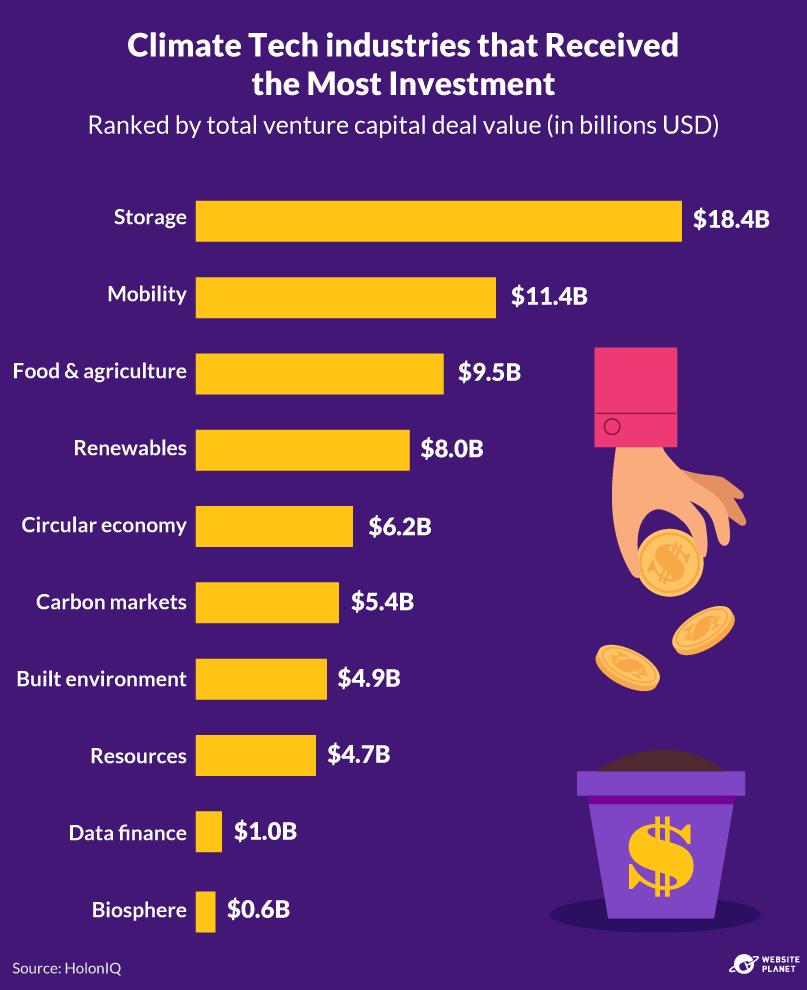 Venture capitalists are betting big on the next wave of climate tech, moving beyond the familiar territories of solar and electric vehicles.
Storage is now leading the charge as the top investment area, scooping up $18.4 billion from 559 deals in 2022. This makes sense because the better we get at generating renewable energy, the more pressing the need to store it.
Investors are also pouring money into decarbonized food, carbon capture tech, and next-generation fuels. These areas are gaining traction because they represent the next frontier in our fight against climate change, offering fresh solutions beyond what’s already becoming standard.
Venture capitalists are betting big on the next wave of climate tech, moving beyond the familiar territories of solar and electric vehicles.
Storage is now leading the charge as the top investment area, scooping up $18.4 billion from 559 deals in 2022. This makes sense because the better we get at generating renewable energy, the more pressing the need to store it.
Investors are also pouring money into decarbonized food, carbon capture tech, and next-generation fuels. These areas are gaining traction because they represent the next frontier in our fight against climate change, offering fresh solutions beyond what’s already becoming standard.
#21: Climate Tech Investment by Continent
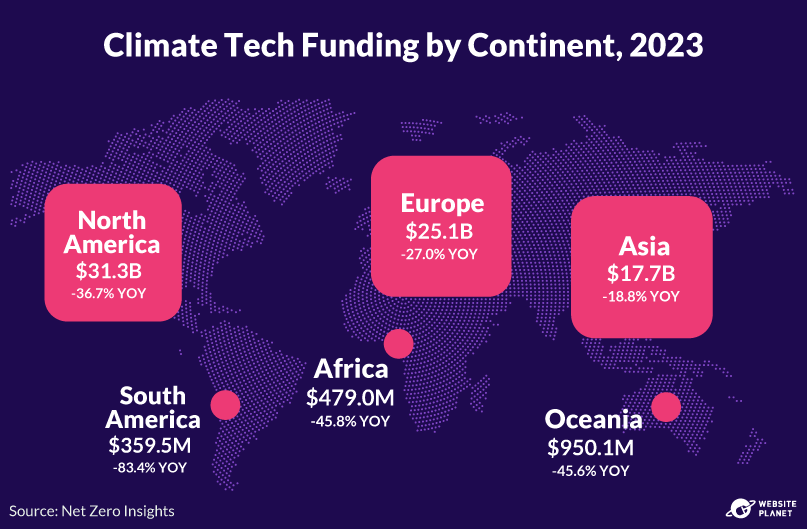 North America, Europe, and China stood out as the top three regions for climate tech investment in 2023.
Despite experiencing a general downturn, the US retained its cumulative lead with significant investments bolstered by the Inflation Reduction Act. Europe, with its $10 billion investment in Q3 alone, capitalized on a decade of growth driven by the European Green Deal and a vibrant startup ecosystem.
Meanwhile, China’s consistent investment efforts have seen it maintain a strong position, indicative of its long-term strategy to reduce the “green premium” in clean technology.
North America, Europe, and China stood out as the top three regions for climate tech investment in 2023.
Despite experiencing a general downturn, the US retained its cumulative lead with significant investments bolstered by the Inflation Reduction Act. Europe, with its $10 billion investment in Q3 alone, capitalized on a decade of growth driven by the European Green Deal and a vibrant startup ecosystem.
Meanwhile, China’s consistent investment efforts have seen it maintain a strong position, indicative of its long-term strategy to reduce the “green premium” in clean technology.
#22: Climate Technology Is the Fastest Growing Investment Market in Europe
 Since 2017, climate tech has emerged as the fastest-growing investment vertical in Europe, second only to fintech. The overall enterprise value of the European climate tech ecosystem reached an estimated $104 billion at the end of 2021, more than doubling from the previous year.
This upswing is a direct result of the European Union’s solid climate agenda and innovation-friendly market. Aggressive climate policies, like halving EU emissions by 2030, along with robust grant offerings, high energy costs, and a society mindful of sustainability have been key drivers.
Since 2017, climate tech has emerged as the fastest-growing investment vertical in Europe, second only to fintech. The overall enterprise value of the European climate tech ecosystem reached an estimated $104 billion at the end of 2021, more than doubling from the previous year.
This upswing is a direct result of the European Union’s solid climate agenda and innovation-friendly market. Aggressive climate policies, like halving EU emissions by 2030, along with robust grant offerings, high energy costs, and a society mindful of sustainability have been key drivers.
#23: The $2 Trillion Push Towards a 40% Emissions Reduction by 2050
 It’s projected that five pivotal technology sectors will collectively attract annual investments of $1.5 trillion to $2 trillion by 2025. Those sectors are electrification, agriculture, the power grid, hydrogen, and carbon capture.
In terms of environmental impact, the widespread deployment of innovations within these climate tech sectors could be instrumental in the global effort to reduce greenhouse gas emissions. Collectively, they have the potential to account for approximately 40% of the emissions reductions required to stabilize the climate by 2050.
It’s projected that five pivotal technology sectors will collectively attract annual investments of $1.5 trillion to $2 trillion by 2025. Those sectors are electrification, agriculture, the power grid, hydrogen, and carbon capture.
In terms of environmental impact, the widespread deployment of innovations within these climate tech sectors could be instrumental in the global effort to reduce greenhouse gas emissions. Collectively, they have the potential to account for approximately 40% of the emissions reductions required to stabilize the climate by 2050.
Employment and Demographics
Climate tech and clean energies are sparking new job opportunities and shaping employment trends. From the increasing job market to the effects of policies like the Inflation Reduction Act, we’re seeing a shift in the workforce landscape – and a growing need for more diversity. As climate tech grows, so does its ability to offer jobs that promise a bright and sustainable future. So, who’s working on saving the planet?#24: Job Impact of the Inflation Reduction Act
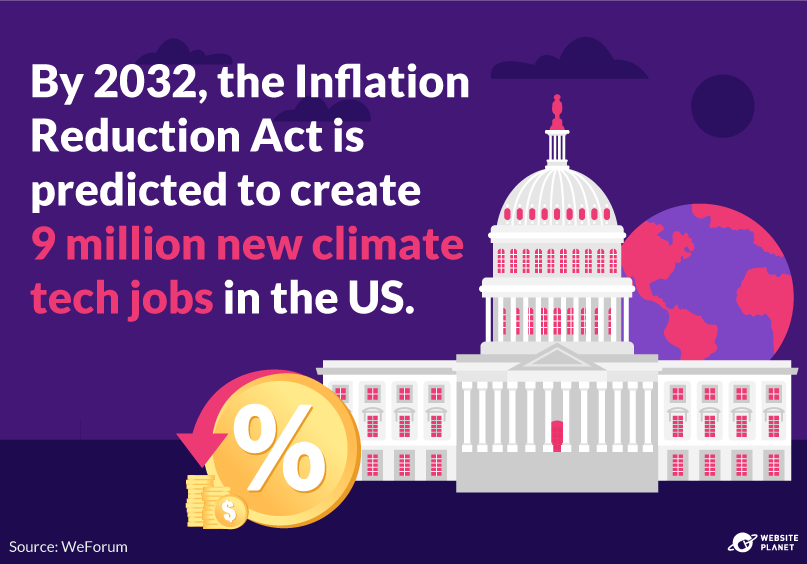 The Inflation Reduction Act, together with the Bipartisan Infrastructure Law, is set to slash US greenhouse gas emissions by as much as 41% from 2005 levels by 2030.
This legislation isn’t just about environmental impact – it’s also a major job creator in the climate tech sector. Since its signing, the act has already spurred the creation of over 170,000 jobs in clean energy and related fields.
By 2032, it’s expected to generate over 9 million jobs across diverse sectors such as electrification, transportation, and manufacturing.
The Inflation Reduction Act, together with the Bipartisan Infrastructure Law, is set to slash US greenhouse gas emissions by as much as 41% from 2005 levels by 2030.
This legislation isn’t just about environmental impact – it’s also a major job creator in the climate tech sector. Since its signing, the act has already spurred the creation of over 170,000 jobs in clean energy and related fields.
By 2032, it’s expected to generate over 9 million jobs across diverse sectors such as electrification, transportation, and manufacturing.
#25: The Rise of Green Jobs
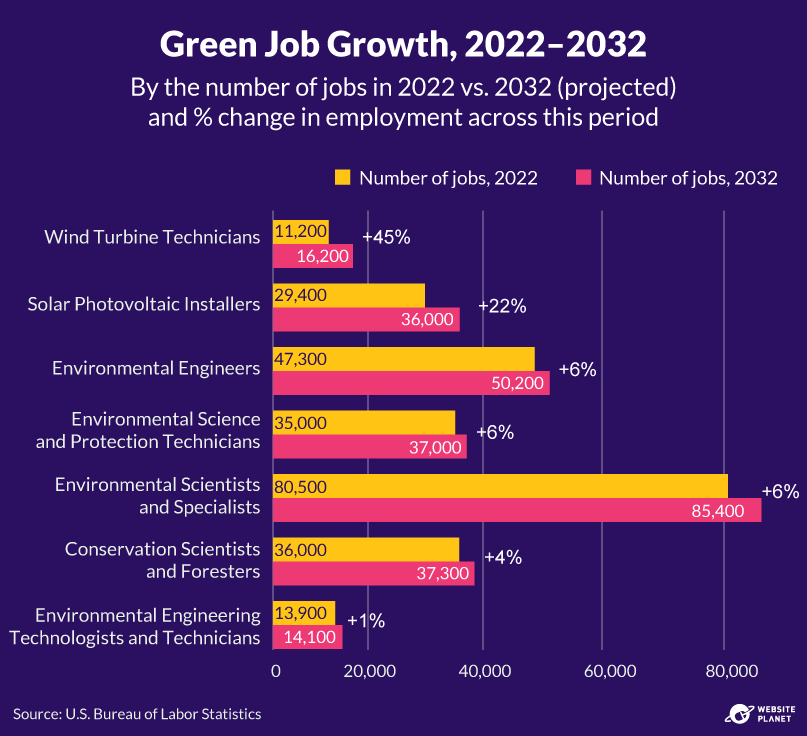 The US Bureau of Labor Statistics (BLS) anticipates significant job growth in green occupations from 2022 to 2032.
Wind turbine service technicians are leading the way with an impressive 45% projected increase in the number of jobs of this title. This is followed by solar photovoltaic installers, which should expand by 22%.
These two job roles are vastly outpacing the average growth rate for all occupations, which hovers at around 3%. This is because they’re essential for building and maintaining systems that harness renewable energy sources, which are quickly growing in popularity.
The US Bureau of Labor Statistics (BLS) anticipates significant job growth in green occupations from 2022 to 2032.
Wind turbine service technicians are leading the way with an impressive 45% projected increase in the number of jobs of this title. This is followed by solar photovoltaic installers, which should expand by 22%.
These two job roles are vastly outpacing the average growth rate for all occupations, which hovers at around 3%. This is because they’re essential for building and maintaining systems that harness renewable energy sources, which are quickly growing in popularity.
#26: Clean Energy Employment Landscape
 Clean energy jobs are central to renewable and low-carbon energy production, playing a critical role in climate change mitigation efforts.
The sector has seen substantial growth, outpacing traditional fossil fuel employment since 2021. This rapid growth in clean energy is propelled by steep declines in the costs of renewable energy, heightened global investment, and global efforts to reduce carbon emissions.
Over half of the job gains can be traced back to a handful of sub-sectors: solar and wind power, electric vehicle and battery production, heat pump installation, and the mining of minerals crucial for technology. Collectively, these fields employed about 9 million people in 2023.
Clean energy jobs are central to renewable and low-carbon energy production, playing a critical role in climate change mitigation efforts.
The sector has seen substantial growth, outpacing traditional fossil fuel employment since 2021. This rapid growth in clean energy is propelled by steep declines in the costs of renewable energy, heightened global investment, and global efforts to reduce carbon emissions.
Over half of the job gains can be traced back to a handful of sub-sectors: solar and wind power, electric vehicle and battery production, heat pump installation, and the mining of minerals crucial for technology. Collectively, these fields employed about 9 million people in 2023.
#27: Diversity in the Clean Energy Sector
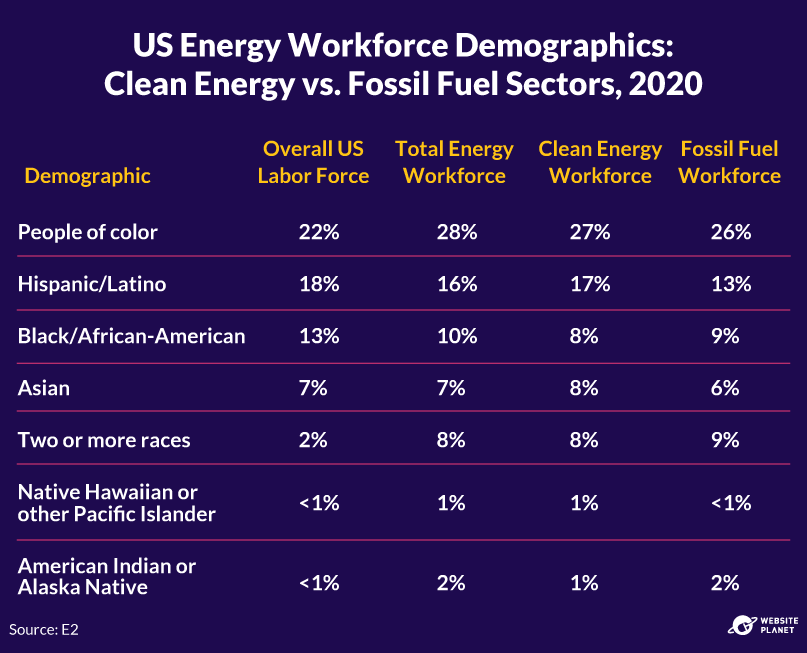 While job opportunities in the clean energy sector are growing, there are some challenges with diversifying its workforce.
A 2021 report found that 61% of clean energy workers are white. Black workers make up just 8% of the clean energy workforce, while Hispanic or Latino workers account for 16.5% – both below their respective levels of representation in the national workforce.
The renewable generation, clean storage, and grid sectors boast the highest diversity rates. This may stem from an increase in targeted training programs that prioritize the inclusion of diverse populations.
While job opportunities in the clean energy sector are growing, there are some challenges with diversifying its workforce.
A 2021 report found that 61% of clean energy workers are white. Black workers make up just 8% of the clean energy workforce, while Hispanic or Latino workers account for 16.5% – both below their respective levels of representation in the national workforce.
The renewable generation, clean storage, and grid sectors boast the highest diversity rates. This may stem from an increase in targeted training programs that prioritize the inclusion of diverse populations.
#28: Women in Climate Tech
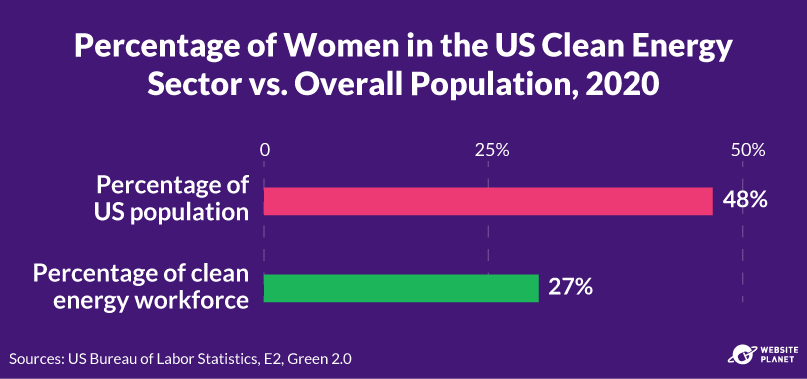 Nearly half of the US workforce is female. However, their footprint in the clean energy sector is significantly smaller, with women occupying less than one-third of the roles.
Gender-based pay disparities remain a stark reality too, with men earning on average 10% more than women across all climate work roles. This gap underscores the critical need for ongoing efforts to not only increase women’s participation in climate tech but also ensure equitable compensation.
Initiatives, like the Clean Energy Corps hiring campaign, are set to bolster female engagement in the field.
Nearly half of the US workforce is female. However, their footprint in the clean energy sector is significantly smaller, with women occupying less than one-third of the roles.
Gender-based pay disparities remain a stark reality too, with men earning on average 10% more than women across all climate work roles. This gap underscores the critical need for ongoing efforts to not only increase women’s participation in climate tech but also ensure equitable compensation.
Initiatives, like the Clean Energy Corps hiring campaign, are set to bolster female engagement in the field.
#29: Demand for Climate Talent Is Increasing
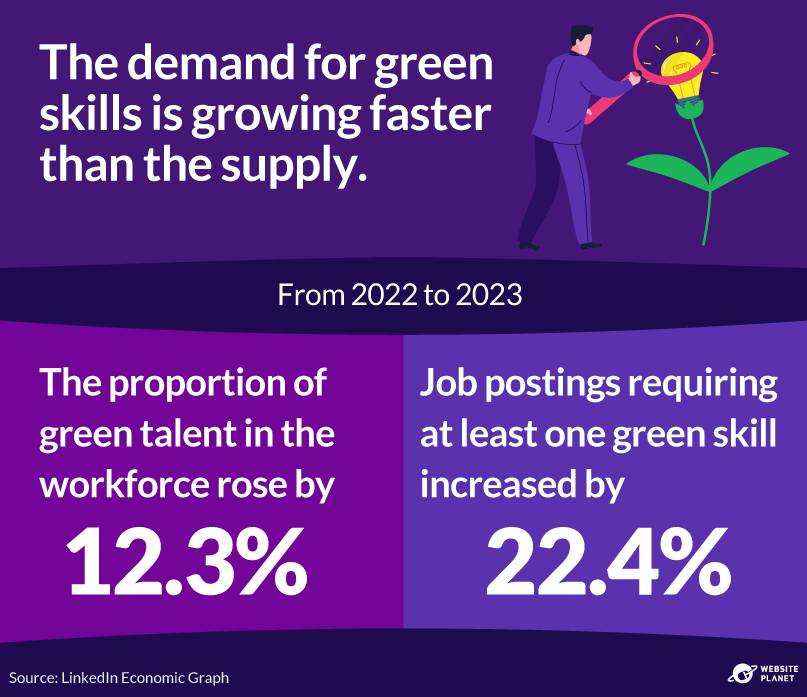 There is a growing market of jobs focused on sustainability, especially in the climate tech sector. Between 2022 and 2023, people who possess green skills were hired at a 29% higher rate than the workforce average.
During the same period, the share of green talent in the workforce rose by 12.3%. However, job postings for roles requiring green skills grew significantly faster, increasing by 22.4%, despite the fact that only one in eight workers possess these skills.
There is a growing market of jobs focused on sustainability, especially in the climate tech sector. Between 2022 and 2023, people who possess green skills were hired at a 29% higher rate than the workforce average.
During the same period, the share of green talent in the workforce rose by 12.3%. However, job postings for roles requiring green skills grew significantly faster, increasing by 22.4%, despite the fact that only one in eight workers possess these skills.
Carbon Reduction Strategies
Carbon reduction strategies are at the forefront of our fight against climate change, from the intricacies of carbon capture and storage to the global drive for net-zero emissions. The Inflation Reduction Act boosts these efforts, providing a financial framework to encourage adoption. AI’s role is increasingly important, optimizing strategies to make them more effective. Together, these efforts are creating strategies against climate change, driving us towards a greener future.#30: The US Carbon Capture and Storage Market
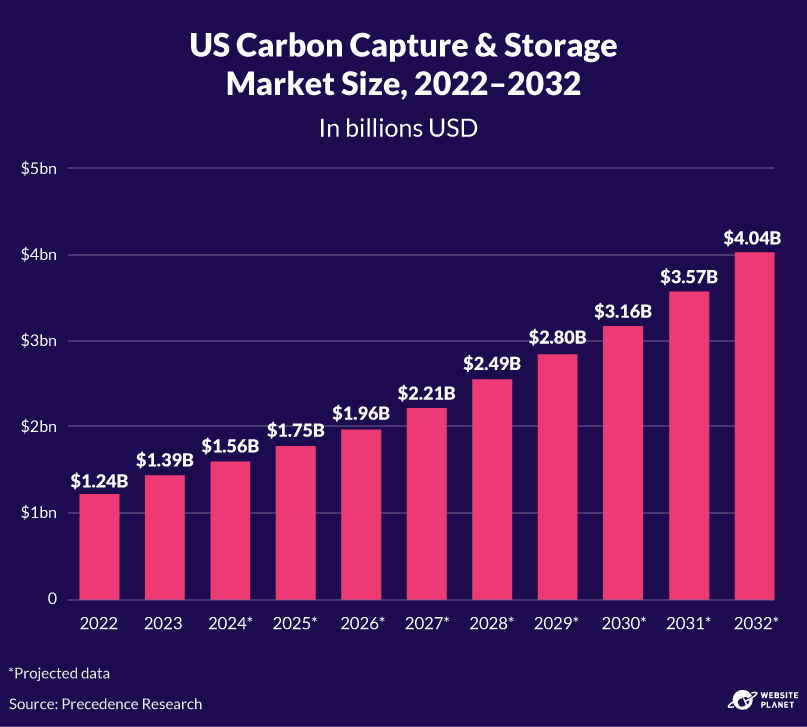 The US Carbon Capture & Storage (CCS) market, which functions to reduce carbon emissions, was valued at $3.28 billion in 2022. Globally, the CCS market is projected to see a 19% annual growth rate over the next decade, reaching $35.4 billion by 2032.
CCS technology captures carbon dioxide (CO2) from sources like power plants, refineries, and other industrial facilities before storing it underground. The market’s growth is driven by environmental concerns, government climate goals, and its use in boosting oil production.
Elon Musk is using his resources to drive CCS technology forward. He launched a four-year contest, offering $100 million in prizes for new CCS innovations – the largest prize pool in history.
The US Carbon Capture & Storage (CCS) market, which functions to reduce carbon emissions, was valued at $3.28 billion in 2022. Globally, the CCS market is projected to see a 19% annual growth rate over the next decade, reaching $35.4 billion by 2032.
CCS technology captures carbon dioxide (CO2) from sources like power plants, refineries, and other industrial facilities before storing it underground. The market’s growth is driven by environmental concerns, government climate goals, and its use in boosting oil production.
Elon Musk is using his resources to drive CCS technology forward. He launched a four-year contest, offering $100 million in prizes for new CCS innovations – the largest prize pool in history.
#31: Global Capacity of Carbon Capture and Storage Facilities Worldwide
 The US is leading the charge in Carbon Capture and Storage (CCS), capturing 23.7 million metric tons of CO2 in 2022. This figure is more than five times greater than Brazil, the country capturing and storing the second largest amount of carbon, and accounts for about half of the global CCS capacity.
What puts the US in the lead? It boils down to strong incentives and supportive policies, like the Inflation Reduction Act of 2022. These measures are designed to accelerate CCS deployment, aligning with the global aim under the Paris Agreement to limit global warming to 1.5°C.
The US is leading the charge in Carbon Capture and Storage (CCS), capturing 23.7 million metric tons of CO2 in 2022. This figure is more than five times greater than Brazil, the country capturing and storing the second largest amount of carbon, and accounts for about half of the global CCS capacity.
What puts the US in the lead? It boils down to strong incentives and supportive policies, like the Inflation Reduction Act of 2022. These measures are designed to accelerate CCS deployment, aligning with the global aim under the Paris Agreement to limit global warming to 1.5°C.
#32: Impact of the Inflation Reduction Act
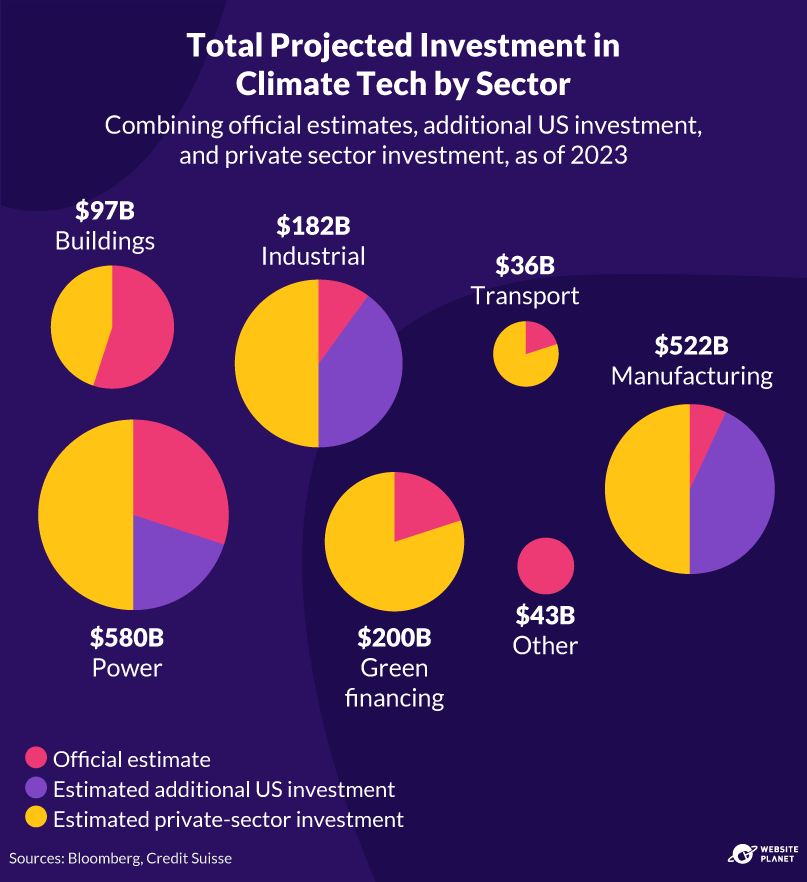 The Inflation Reduction Act (IRA) is a legislative measure aimed at funding climate tech and reducing its cost in the US. Initial projections put the allocation at $369 billion, but updated figures now estimate a total government investment of $515 billion in climate tech in the 10 years ended 2032.
Since its implementation, the IRA has seemingly catalyzed $76 billion in announced investments for US-based facilities. Specifically, 62 projects related to electric vehicles and batteries have attracted $53 billion in planned private funding. Analysts predict that the Inflation Reduction Act could help the US achieve a 40% reduction in emissions from 2005 levels by 2030.
The Inflation Reduction Act (IRA) is a legislative measure aimed at funding climate tech and reducing its cost in the US. Initial projections put the allocation at $369 billion, but updated figures now estimate a total government investment of $515 billion in climate tech in the 10 years ended 2032.
Since its implementation, the IRA has seemingly catalyzed $76 billion in announced investments for US-based facilities. Specifically, 62 projects related to electric vehicles and batteries have attracted $53 billion in planned private funding. Analysts predict that the Inflation Reduction Act could help the US achieve a 40% reduction in emissions from 2005 levels by 2030.
#33: Charting the Path to Net-Zero Emissions in Aviation
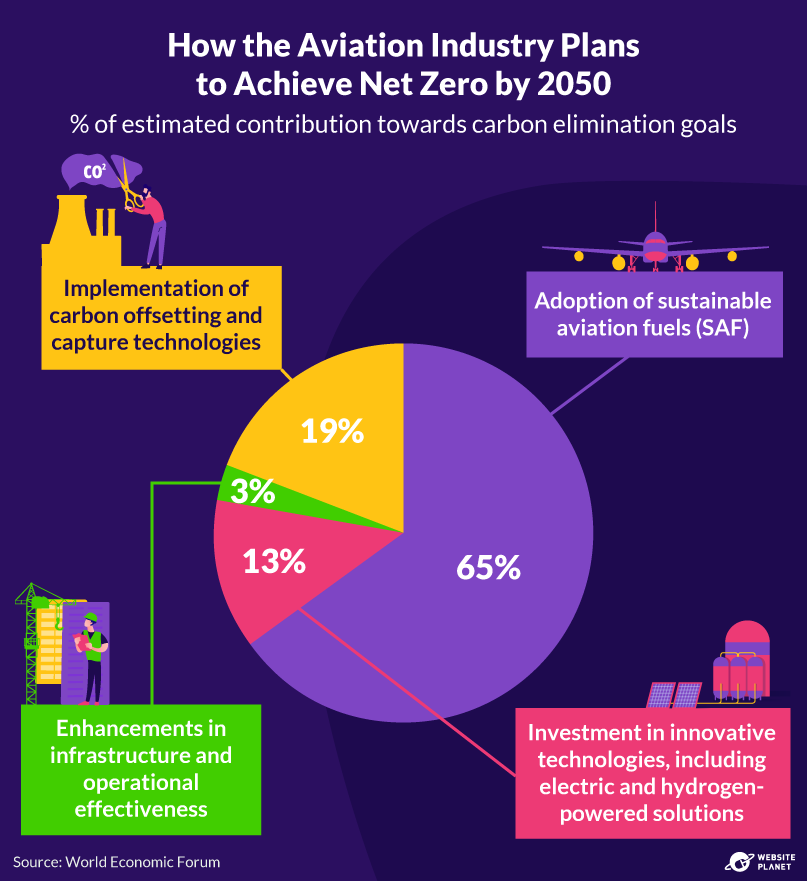 The aviation industry aims to achieve net-zero emissions by 2050, aligning with the Paris Agreement’s climate goals. Key strategies include the use of sustainable aviation fuels (SAF) and the adoption of innovative climate tech.
A research team at ETH Zurich designed a tower that harnesses solar power to split carbon dioxide and water from the air and turn them into carbon-neutral jet fuel. Scientists in South Africa and Germany are working together to produce green kerosene in the hopes that the industry could begin to shift to using this fuel as early as 2025.
Meanwhile, Swedish start-up Heart Aerospace is developing electric planes capable of 200 kilometer flights and a 30-minute recharge time, targeting service launch by 2028.
The aviation industry aims to achieve net-zero emissions by 2050, aligning with the Paris Agreement’s climate goals. Key strategies include the use of sustainable aviation fuels (SAF) and the adoption of innovative climate tech.
A research team at ETH Zurich designed a tower that harnesses solar power to split carbon dioxide and water from the air and turn them into carbon-neutral jet fuel. Scientists in South Africa and Germany are working together to produce green kerosene in the hopes that the industry could begin to shift to using this fuel as early as 2025.
Meanwhile, Swedish start-up Heart Aerospace is developing electric planes capable of 200 kilometer flights and a 30-minute recharge time, targeting service launch by 2028.
#34: Leaders Champion AI’s Role in Climate Action
 The vast majority (87%) of CEOs recognize AI as an essential ally in the fight against climate change. These business leaders see AI’s potential to measure emissions and analyze data to reduce carbon outputs and optimize energy consumption
Despite this optimism, however, there exists a notable disconnect in the market. Only 43% of these leaders have a clear strategy for employing AI in climate technology initiatives. This gap underscores a broader issue: while the potential of AI in climate action is widely acknowledged, the path to its integration and application remains murky for many.
The vast majority (87%) of CEOs recognize AI as an essential ally in the fight against climate change. These business leaders see AI’s potential to measure emissions and analyze data to reduce carbon outputs and optimize energy consumption
Despite this optimism, however, there exists a notable disconnect in the market. Only 43% of these leaders have a clear strategy for employing AI in climate technology initiatives. This gap underscores a broader issue: while the potential of AI in climate action is widely acknowledged, the path to its integration and application remains murky for many.
Conclusion
Amid the increasing ubiquity of climate tech, the journey towards a sustainable future is an exciting one. With the market projected to grow to $183 billion by 2023, it’s clear that there is now a collective push towards creating and using innovative tools to build a sustainable future. Aside from investment trends, the shifts that we’re seeing in how the world approaches energy production, manufacturing, and even agriculture are a positive reflection of our commitment to combating climate change and preserving our planet. However, the journey towards our sustainable future is complex and requires the best efforts of governments, businesses, and individuals. By staying informed about the advancements and trends in this exciting industry, we can ensure that we make a positive contribution towards bettering our outcomes. As we each embrace this responsibility, we join a collective movement towards a thriving and healthy planet.Content attribution: Website Planet is the sole owner of the visual and written content on this website. You are free to share our content and visuals on your site, but we ask that you provide a link back to the resource if you do, enabling us to continue providing authoritative reviews and guides to help individuals and businesses thrive online.













